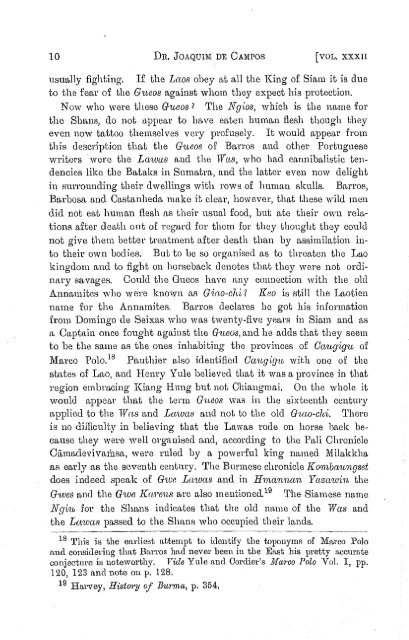The Journal of the Siam Society Vol. XXXII, 1940 - Khamkoo
The Journal of the Siam Society Vol. XXXII, 1940 - Khamkoo
The Journal of the Siam Society Vol. XXXII, 1940 - Khamkoo
You also want an ePaper? Increase the reach of your titles
YUMPU automatically turns print PDFs into web optimized ePapers that Google loves.
10 Dn. JoAQUIM DE CAMPos<br />
usun.lly fighting. If <strong>the</strong> Laos obey at all <strong>the</strong> King <strong>of</strong> <strong>Siam</strong> it is due<br />
to <strong>the</strong> fear <strong>of</strong> Lhe G1.wos against whom <strong>the</strong>y expect his protection.<br />
NO\v who \Vere <strong>the</strong>se Gneos 2 <strong>The</strong> Ngios, which is <strong>the</strong> name for<br />
<strong>the</strong> Shans, do noL appear to have eaten human flesh though <strong>the</strong>y<br />
even now tattoo <strong>the</strong>mselves very pr<strong>of</strong>usely. It would appear from<br />
this description that <strong>the</strong> G1wos <strong>of</strong> Barros and o<strong>the</strong>r Portuguese<br />
writers were <strong>the</strong> Lawas and <strong>the</strong> Was, who had cannibalistic tendencies<br />
like <strong>the</strong> Bataks in Sumatra, and <strong>the</strong> latter even now delight<br />
in surrounding <strong>the</strong>ir dwe1lings with rows <strong>of</strong> human skulls. Barros,<br />
Barbosa and Castanheda make it clear, however, that <strong>the</strong>se wild men<br />
did not eat human flesh as <strong>the</strong>ir usual food, but ate <strong>the</strong>ir own relations<br />
after death out <strong>of</strong> regard for <strong>the</strong>m for <strong>the</strong>y thought <strong>the</strong>y could<br />
not give <strong>the</strong>m better treLthnent after death than by assimilation into<br />
<strong>the</strong>ir own bodies. But to be so organised as to threaten <strong>the</strong> Lao<br />
kingdom and Lo fight on horseback denotes that <strong>the</strong>y were not ordinary<br />
savages. Could <strong>the</strong> Gneos have any connection with <strong>the</strong> old<br />
Annamites who were known aR Gicw-chi? !{eo is still <strong>the</strong> Laoticn<br />
name for <strong>the</strong> Annamites. Barros declares he got his information<br />
from Domingo de Seixas who was twenty-five years in <strong>Siam</strong> and as<br />
a Captain once fought against <strong>the</strong> G1wos, and he adds that <strong>the</strong>y seem<br />
to be <strong>the</strong> same as <strong>the</strong> ones inhabiting <strong>the</strong> provinces <strong>of</strong> Octugigu <strong>of</strong><br />
Marco Polo.l 8 Pauthier also identified Owngig·n wit,h one <strong>of</strong> <strong>the</strong><br />
states o£ Lao, .and Henry Yule believed that it was a province in that<br />
region embracing Kiang Hung but not Chiangmai. On <strong>the</strong> whole it<br />
would appear that <strong>the</strong> term Gueos w11s in <strong>the</strong> sixteenth century<br />
applied to <strong>the</strong> Was and Lc~was and not to <strong>the</strong> old Guw-chi. 'l'here<br />
is no diificnlty in believing that <strong>the</strong> Lawas rode on horse back because<br />
<strong>the</strong>y were well organised and, according to <strong>the</strong> Pali Chronicle<br />
CamadeviValnsa, were ruled by a powerful king named Milakkha<br />
as early as <strong>the</strong> seventh centnry. 'fhe Burmese chronicle Kombnungset<br />
does indeed speak <strong>of</strong> Gwe Lc~was and in Hmannan Yw?;awin <strong>the</strong><br />
Gwes and <strong>the</strong> Gwe Kc~1·ens are also mentioned. 19 'rhe <strong>Siam</strong>ese name<br />
Ng·i1u for <strong>the</strong> Shans indicates that <strong>the</strong> old mtme <strong>of</strong> <strong>the</strong> Was and<br />
<strong>the</strong> Lctwas passed to <strong>the</strong> Shnns who occupied <strong>the</strong>ir lands.<br />
18 'l'his i~> <strong>the</strong> ernliest 11ttempt to identify <strong>the</strong> toponyrns <strong>of</strong> :M:n,rco Polo<br />
and conside1·ing th11t Bn,r1•os hn,d neve1· been in <strong>the</strong> En.st his pretty nccurate<br />
conjectme is noteworthy. Vide Yule nnd Cordier's fi{c~1·co Polo <strong>Vol</strong>. I, pp.<br />
120, 123 and note on p. 128.<br />
19 HaPvey, Hist01·y <strong>of</strong> B1t1'rluc., p. 354,

















